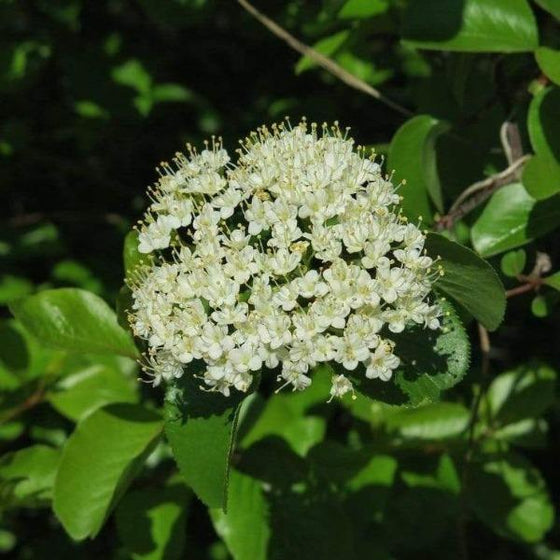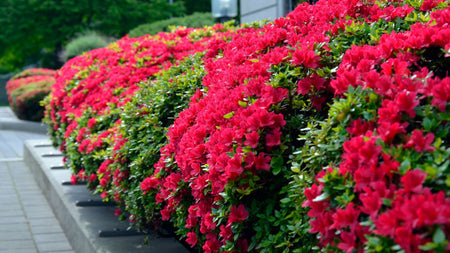
Images Depict Mature Plants
Blackhaw Viburnum Shrubs for Sale Online
Blackhaw Viburnum (Viburnum prunifolium) is a versatile and hardy native shrub that thrives in USDA Hardiness Zones 3-9. Reaching a mature height of 12-15 feet tall and spreading 6-12 feet wide, it’s ideal for use as a hedge, privacy screen, or as a striking specimen plant in the landscape. This deciduous shrub produces clusters of creamy-white flowers in late spring, which attract pollinators like bees and butterflies. Following the blooms, Blackhaw Viburnum develops blue-black berries in the fall that are ornamental and a valuable food source for birds and wildlife.
The dark green foliage of Blackhaw Viburnum transforms into stunning shades of red, orange, and purple in the fall, providing beautiful autumn color in the garden. Its ability to thrive in both full sun and partial shade makes it adaptable to a variety of garden settings, from woodland gardens to more formal landscapes. Blackhaw Viburnum is also highly drought-tolerant once established and can grow in a wide range of soil types, from dry, rocky soil to richer, loamy conditions. This makes it a low-maintenance, resilient option for gardeners looking to add year-round interest and wildlife value to their landscapes.
In addition to its ecological benefits, Blackhaw Viburnum is deer-resistant, adding to its appeal for gardens in areas with high wildlife activity. Its dense growth habit makes it an excellent choice for natural privacy barriers, while its seasonal flowers and berries offer visual interest throughout the year. Whether planted as a backdrop in mixed borders, as a screen along property lines, or as a feature in native plant gardens, Blackhaw Viburnum brings beauty, adaptability, and ecological value to any landscape.

| Hardiness Zone: | 3-9 |
|---|---|
| Mature Height: | 12 to 15 Feet |
| Mature Width: | 6 to 12 Feet |
| Classification: | Broad leaved semi-evergreen shrub, spring flowering |
| Sunlight: | Full sun to partial shade |
| Habit: | Upright, densely branched |
| Foliage: | Dark green |
| Flower Color: | White, very fragrant in May |
| Pruning Season: | Prune in summer after flowering |
| Soil Condition: | Any well drained soil |
| Water Requirements: | Water well until established |
| Uses: | Extremely attractive when used as a focal point in the mixed border, mass planting, or a specimen planting |
How to Care for Blackhaw Viburnum
Be sure to read our planting instructions to ensure a healthy and happy Blackhaw Viburnum for years to come!
How Do I Plant Blackhaw Viburnum Shrubs?
To plant Blackhaw Viburnum shrubs, start by selecting a location with well-drained soil and full sun to partial shade. This versatile shrub thrives in various soil types, from dry, rocky soil to richer, loamy conditions. Dig a hole that is twice as wide and just as deep as the root ball, ensuring the top of the root ball is level with the soil surface. Place the shrub in the hole, backfill with soil, and gently firm the soil around the roots to remove any air pockets. Water thoroughly after planting to help the plant settle in. If planting multiple Blackhaw Viburnum shrubs, space them 6-12 feet apart to allow for their mature size and optimal growth. Mulching around the base of the shrub will help retain soil moisture, regulate temperature, and suppress weeds, especially during the first growing season. Keep the soil consistently moist until the plant is established, after which Blackhaw Viburnum becomes more drought-tolerant. This low-maintenance shrub is perfect for creating natural privacy screens, mixed borders, or wildlife-friendly gardens. With proper planting and care, Blackhaw Viburnum will thrive, offering year-round beauty with its spring blooms, vibrant fall foliage, and attractive berries that draw birds and other wildlife to your landscape.
How Do I Water Blackhaw Viburnum Shrubs?
To water Blackhaw Viburnum shrubs, ensure the soil remains consistently moist during the first growing season to help establish a strong root system. Water deeply once or twice a week, especially during hot or dry periods, allowing the water to penetrate the root zone. Be sure to avoid waterlogging, as Blackhaw Viburnum prefers well-drained soil. Mulching around the base of the shrub will help retain moisture, prevent evaporation, and regulate soil temperature, especially in hotter climates. The goal is to keep the soil consistently moist, but not soggy, to promote healthy growth and root development. Once established, Blackhaw Viburnum becomes more drought-tolerant and requires less frequent watering. Typically, the shrub will thrive with natural rainfall, but during prolonged dry spells or extreme heat, supplemental watering is beneficial to maintain its health and vigor. Check the soil periodically, and if the top few inches are dry, water deeply to ensure the roots receive enough moisture. Proper watering not only supports the shrub's attractive spring blooms and vibrant fall foliage but also encourages the production of its signature wildlife-friendly berries. With the right watering routine, Blackhaw Viburnum will flourish and provide year-round interest in your landscape.
How Do I Fertilize Blackhaw Viburnum Shrubs?
To fertilize Blackhaw Viburnum shrubs, apply a balanced, slow-release fertilizer in early spring just before new growth begins. A general-purpose 10-10-10 or 14-14-14 fertilizer will provide essential nutrients like nitrogen, phosphorus, and potassium to promote healthy foliage, vibrant blooms, and strong root development. Spread the fertilizer evenly around the base of the shrub, making sure to avoid direct contact with the trunk or leaves. Water thoroughly after applying to help the nutrients penetrate the soil and reach the roots. Typically, Blackhaw Viburnum only needs one application of fertilizer per year for optimal growth. For gardeners who prefer organic methods, applying compost or well-rotted manure in early spring can enhance the soil’s nutrient content and improve moisture retention. Simply spread a 2-3 inch layer of organic material around the shrub’s base, keeping it a few inches away from the trunk to prevent rot. Avoid over-fertilizing, as excessive nitrogen can lead to overly vigorous leaf growth at the expense of flowers and berries. With proper fertilization, Blackhaw Viburnum will produce abundant blooms, colorful fall foliage, and berries that attract wildlife, ensuring the shrub thrives in your garden year-round.

How Do I Prune Blackhaw Viburnum Shrubs?
To prune Blackhaw Viburnum shrubs, the best time is in late winter or early spring, before new growth begins. Start by removing any dead, damaged, or diseased branches to improve the overall health of the shrub. Use clean, sharp pruning shears to make precise cuts just above a healthy bud or at the base of the branch. Thinning out some of the inner branches will also promote better air circulation and light penetration, which helps prevent disease and encourages strong, healthy growth. Avoid cutting more than a third of the plant’s overall size to avoid stressing the shrub. If needed, you can also prune Blackhaw Viburnum after it finishes blooming in late spring to maintain its desired shape and size. Lightly trim the outer branches to shape the plant, keeping its natural form intact. This shrub has an attractive, vase-shaped habit, so avoid heavy pruning that might disrupt its natural structure. Regular light pruning encourages more blooms and enhances berry production, providing additional interest in the fall. With proper pruning, Blackhaw Viburnum will remain healthy, produce abundant flowers, and offer year-round beauty and structure in your landscape.


















